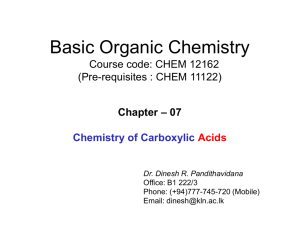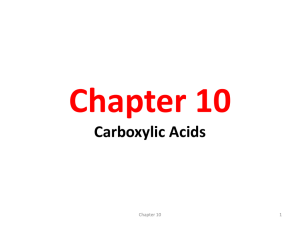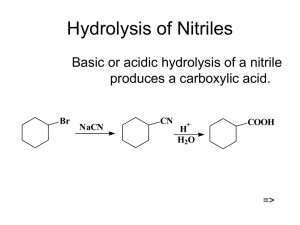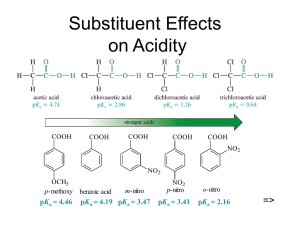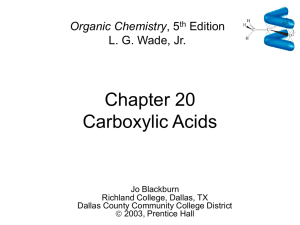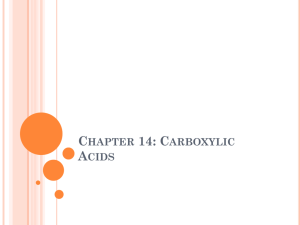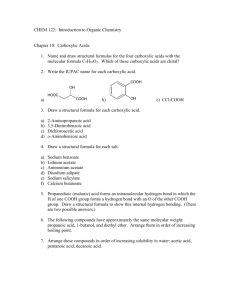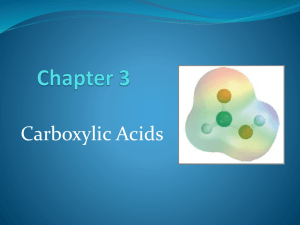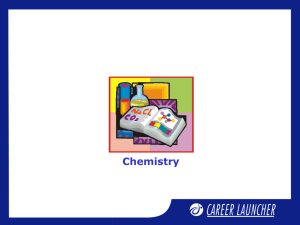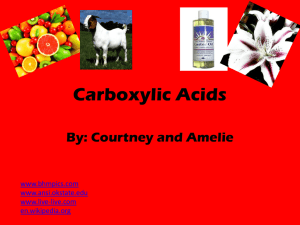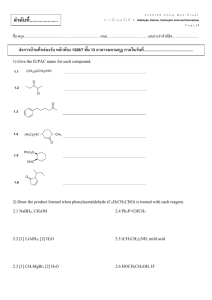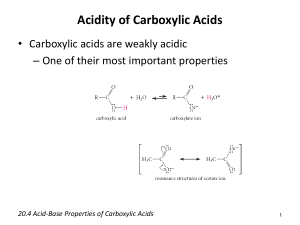Chapter 20 Carboxylic Acids - chemistry
advertisement
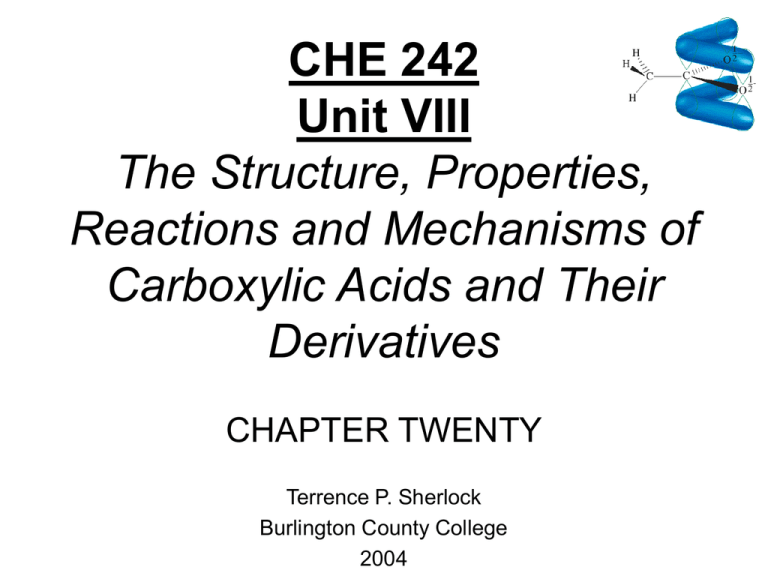
CHE 242 Unit VIII The Structure, Properties, Reactions and Mechanisms of Carboxylic Acids and Their Derivatives CHAPTER TWENTY Terrence P. Sherlock Burlington County College 2004 Common Names • Many aliphatic acids have historical names. • Positions of substituents on the chain are labeled with Greek letters. Ph Cl O CH3CH2CHC OH CH3CH2CH2CHCH2COOH -phenylcaproic acid -chlorobutyric acid Chapter 20 2 => IUPAC Names • Remove -e from alkane (or alkene) name, add -oic acid. • The carbon of the carboxyl group is #1. Cl O Ph CH3CH2CHC OH H H C C COOH 2-chlorobutanoic acid trans-3-phenyl-2-propenoic acid (cinnamic acid) => Chapter 20 3 Naming Cyclic Acids • Cycloalkanes bonded to -COOH are named as cycloalkanecarboxylic acids. • Aromatic acids are named as benzoic acids. COOH COOH OH CH(CH3)2 2-isopropylcyclopentanecarboxylic acid o-hydroxybenzoic acid (salicylic acid) => Chapter 20 4 Dicarboxylic Acids • Aliphatic diacids are usually called by their common names (to be memorized). • For IUPAC name, number the chain from the end closest to a substituent. • Two carboxyl groups on a benzene ring indicate a phthalic acid. Br HOOCCH2CHCH2CH2COOH 3-bromohexanedioic acid -bromoadipic acid Chapter 20 => 5 Structure of Carboxyl • Carbon is sp2 hybridized. • Bond angles are close to 120. • O-H eclipsed with C=O, to get overlap of orbital with orbital of lone pair on oxygen. => Chapter 20 6 Boiling Points Higher boiling points than similar alcohols, due to dimer formation. Acetic acid, b.p. 118C Chapter 20 => 7 Melting Points • Aliphatic acids with more than 8 carbons are solids at room temperature. • Double bonds (especially cis) lower the melting point. Note these 18-C acids: Stearic acid (saturated): 72C Oleic acid (one cis double bond): 16C Linoleic acid (two cis double bonds): -5C => Chapter 20 8 Solubility • Water solubility decreases with the length of the carbon chain. • Up to 4 carbons, acid is miscible in water. • More soluble in alcohol. • Also soluble in relatively nonpolar solvents like chloroform because it dissolves as a dimer. => Chapter 20 9 Acidity => Chapter 20 10 Resonance Stabilization => Chapter 20 11 Substituent Effects on Acidity COOH COOH COOH COOH COOH NO2 NO2 OCH3 p-methoxy benzoic acid pKa = 4.46 NO2 p-nitro m-nitro pKa = 4.19 pKa = 3.47 pKa = 3.41 Chapter 20 o-nitro pKa = 2.16 => 12 IR Spectroscopy => Chapter 20 13 NMR Spectroscopy => Chapter 20 14 Synthesis Review • Oxidation of primary alcohols and aldehydes with chromic acid. • Cleavage of an alkene with hot KMnO4 produces a carboxylic acid if there is a hydrogen on the double-bonded carbon. • Alkyl benzene oxidized to benzoic acid by hot KMnO4 or hot chromic acid. => Chapter 20 15 Grignard Synthesis Grignard reagent + CO2 yields a carboxylate salt. CH3 CH3 CH3CH3CHCH2MgBr O C O + - + CH3CH3CHCH2COO MgBr H CH3 CH3CH3CHCH2COOH => Chapter 20 16 Hydrolysis of Nitriles Basic or acidic hydrolysis of a nitrile produces a carboxylic acid. Br NaCN CN + H H2O COOH => Chapter 20 17 Acid Derivatives • The group bonded to the acyl carbon determines the class of compound: -OH, carboxylic acid -Cl, acid chloride -OR’, ester -NH2, amide • These interconvert via nucleophilic acyl substitution. => Chapter 20 18 Fischer Esterification • • • • Acid + alcohol yields ester + water. Acid catalyzed for weak nucleophile. All steps are reversible. Reaction reaches equilibrium. O COOH + H + CH3CH2OH COCH2CH3 + HOH => Chapter 20 19 Fischer Mechanism (1) Protonation of carbonyl and attack of alcohol, a weak nucleophile. O COH + H + OH OH COH COH + OH OH CH3CH2OH COH O+ H CH2CH3 H O R COH O CH2CH3 => Chapter 20 20 Fischer Mechanism (2) Protonation of -OH and loss of water. + H OH H + OH C OH + C OH O O O CH2CH3 CH2CH3 COH CH2CH3 H O C O R O CH2CH3 => Chapter 20 21 Acid Chlorides • An activated form of the carboxylic acid. • Chloride is a good leaving group, so undergoes acyl substitution easily. • To synthesize acid chlorides use thionyl chloride or oxalyl chloride with the acid. O O C OH + O O C Cl C C Cl + HCl + CO + CO2 Cl => Chapter 20 22 Esters from Acid Chlorides • Acid chlorides react with alcohols to give esters in good yield. • Mechanism is nucleophilic addition of the alcohol to the carbonyl as chloride ion leaves, then deprotonation. O O CCl COCH3 + CH3OH + HCl Chapter 20 => 23 Amides from Acid Chlorides • Acid chlorides react with ammonia and amines to give amides. • A base (NaOH or pyridine) is added to remove HCl by-product. O O CCl CNHCH3 + CH3NH2 NaOH + NaCl + H2O => Chapter 20 24 Diazomethane • CH2N2 reacts with carboxylic acids to produce methyl esters quantitatively. • Very toxic, explosive. Dissolve in ether. O O C OH C OCH 3 + CH2N2 + N2 => Chapter 20 25 Amides from Acids • Amine (base) removes a proton from the carboxylic acid to form a salt. • Heating the salt above 100C drives off steam and forms the amide. O O O C OH CH NH + 3 2 C O- +NH CH 3 3 C NHCH 3 heat + H2O => Chapter 20 26 Reduction to 1 Alcohols • Use strong reducing agent, LiAlH4. • Borane, BH3 in THF, reduces carboxylic acid to alcohol, but does not reduce ketone. Chapter 20 27 => Reduction to Aldehyde • Difficult to stop reduction at aldehyde. • Use a more reactive form of the acid (an acid chloride) and a weaker reducing agent, lithium aluminum tri(t-butoxy)hydride. O O CCl LiAl[OC(CH3)3]3H C H => Chapter 20 28 Alkylation to Form Ketones React 2 equivalents of an organolithium reagent with a carboxylic acid. O COOH 1) 2 CH3CH2 Li C CH CH 2 3 2) H2O => Chapter 20 29 POWER POINT IMAGES FROM “ORGANIC CHEMISTRY, 5TH EDITION” L.G. WADE ALL MATERIALS USED WITH PERMISSION OF AUTHOR PRESENTATION ADAPTED FOR BURLINGTON COUNTY COLLEGE ORGANIC CHEMISTRY COURSE BY: ANNALICIA POEHLER STEFANIE LAYMAN CALY MARTIN Chapter 20 30
